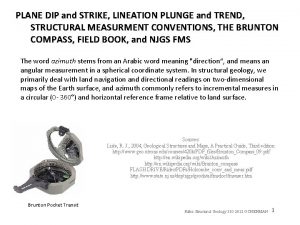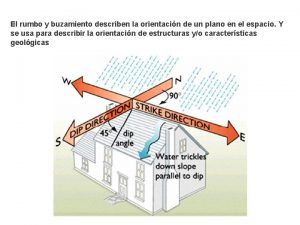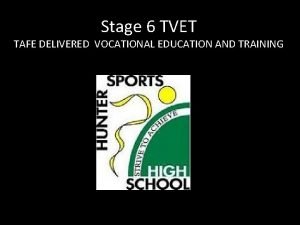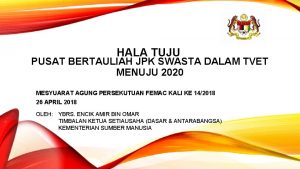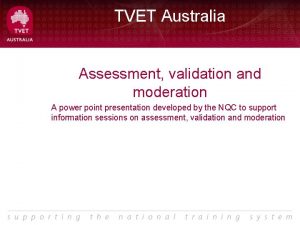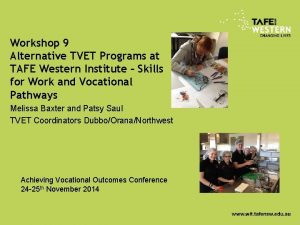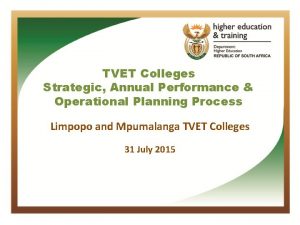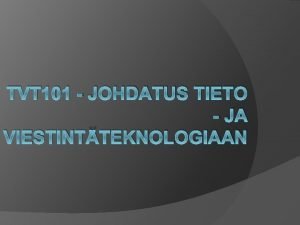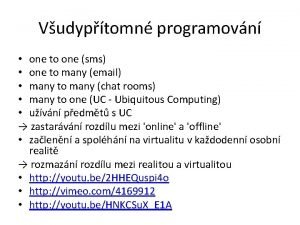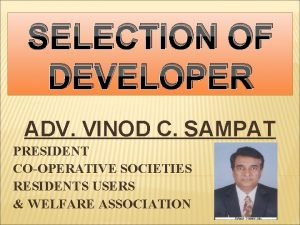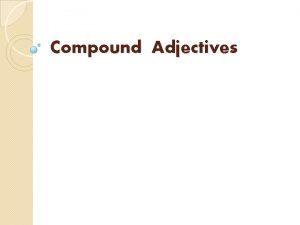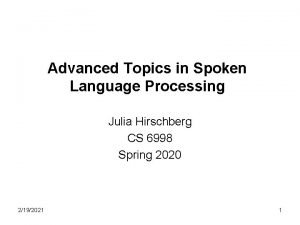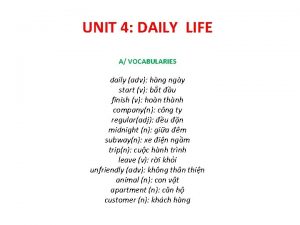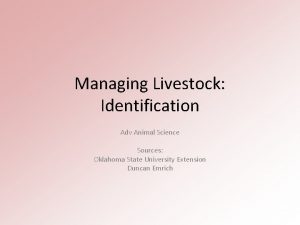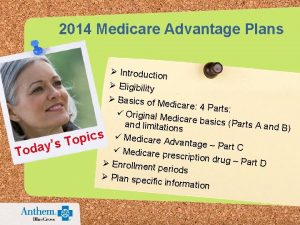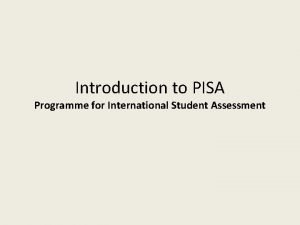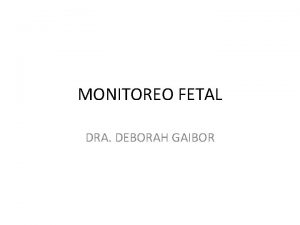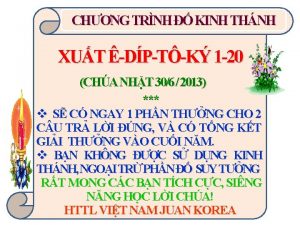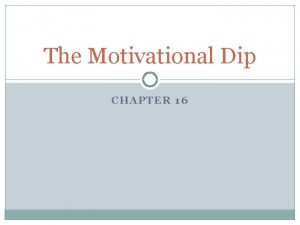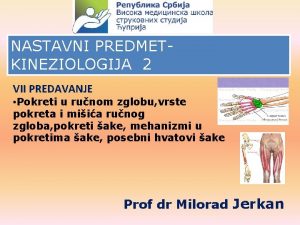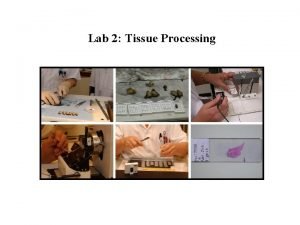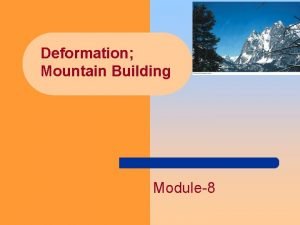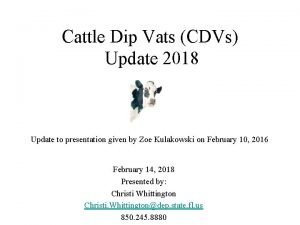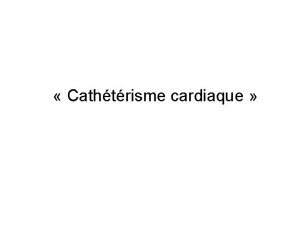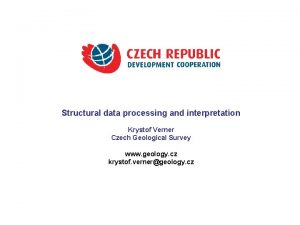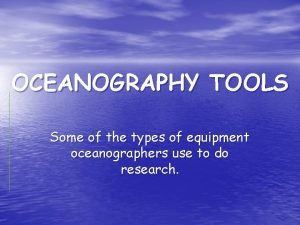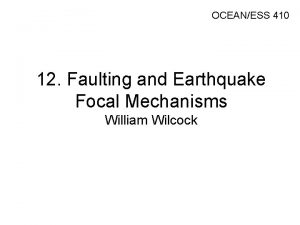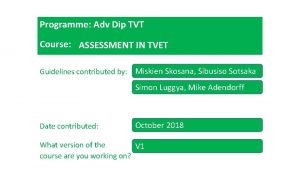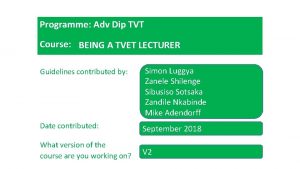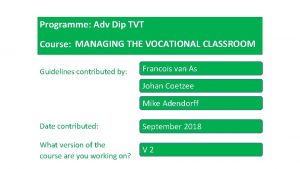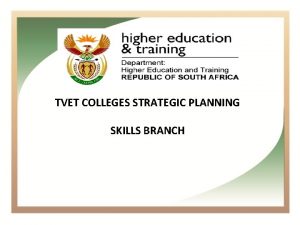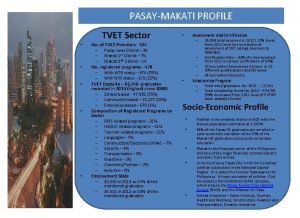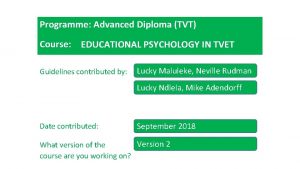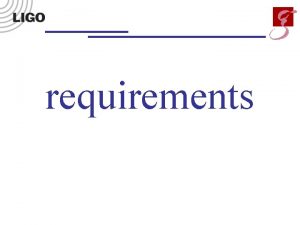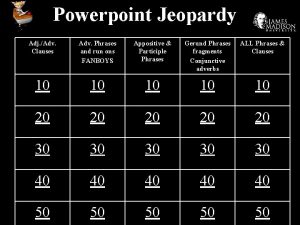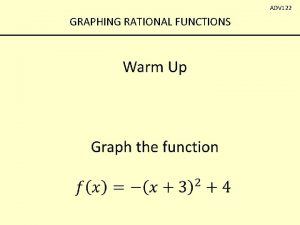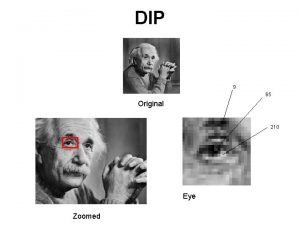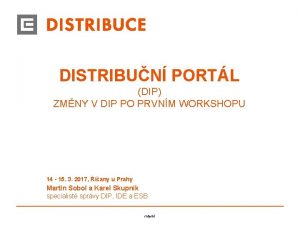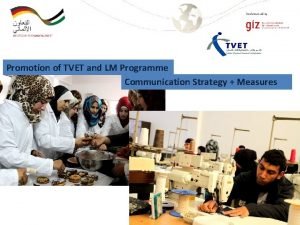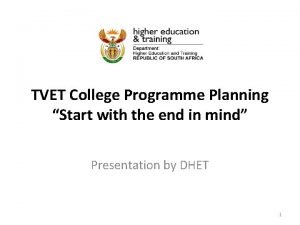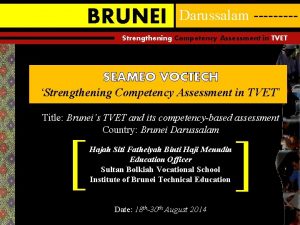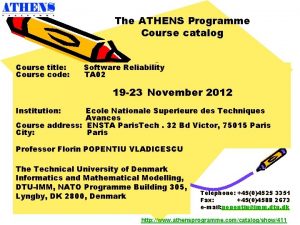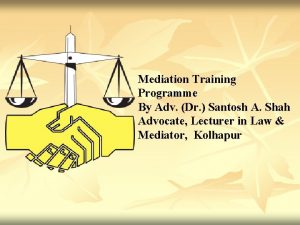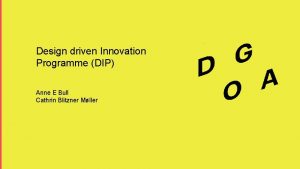Programme Adv Dip TVT Course ASSESSMENT IN TVET












































- Slides: 44

Programme: Adv Dip TVT Course: ASSESSMENT IN TVET Guidelines contributed by: Mike Adendorff, Miskien Skosana, Sibusiso Sotsaka, Simon Luggya Date contributed: October 2018 What version of the V 2 course are you working on?

Points for subject experts, learning designers etc. to keep in mind General principles • State the purpose/reason for including each item (e. g. video, activity, reading) below, and if possible its place in the learning design of theme as a whole. • Always consider the likely possible contexts of learners who may study theme / take the course. • Think of innovative means to lead the learner into using new discourses and ways of understanding by engaging them on the level of the familiar / prior knowledge, or possibly by challenging or disrupting the familiar. • Include learning activity and assessment which calls forth a full range of levels of cognitive engagement and skill development. • Avoid the approach that seeks to attain outcomes by relying on “atomised checklists of micro-competences” (Hager, 2004).

Points for subject experts, learning designers etc. to keep in mind • The Advanced Diploma TVT (Adv Dip TVT) courses should be designed as resource-based. However, the resources should not simply be seen as “add-ons” or “extras”. Two ways in which they can be introduced to students: • Embed hypertext links to resources (readings, official documents, videos) in passages of text. • Include self-assessment or reflection tools in the course in which students’ responses to a small number of limited-choice questions activate the presentation of links to particular selections of resources suitable to the individual students’ needs or interests. These selections do not need to be completely different, tailormade selections, and may overlap to a considerable extent, but where the number of available or easily-produced OERs allows some degree of personalization, this technique should be employed (once or twice in a course). • The text-based and graphic resources should be downloadable and in a printable format. However, the resources should not be in pdf format, as this would not allow for re-mixing or any form of adaptation; in other words, they will automatically be equivalent to a “No derivatives” licence. Where audio or video resources are really crucial to completion of

Points for subject experts, learning designers etc. to keep in mind …the course, consider, respectively, summarised transcripts or simplified comic-like representations of the video using screen-grabs and subtitles or captions. • Videos should not be either simply “talking heads + monologue”, or video representations of what is essentially a powerpoint presentation. Videos should focus on subjects such as processes, reallife situations, in-location interviews or focus groups. • Standardised signposting is to be used throughout courses, so that the look and feel of Adv Dip TVT materials will all be instantly recognizable. • The EU and DHET logos should appear on the upper or lower left and right corners respectively of the opening screen of each course, and of all videos, animations, powerpoints, readings or other resources created for the project (approximately the same size – see examples in next slide). • Chat rooms (synchronous) and discussion forums (asynchronous) play an important role in the Adv Dip TVT courses, especially as many of the students are themselves lecturers with a lot of experience, even if they have lacked professional qualifications as TVET lecturers. • The learning outcomes, and possibly the key questions, need to be introduced in a way that locates them as central to the course. All learning activities and assessments, as well as the resources, need to be visibly linked/aligned to the LOs.

Note to lecturers Credit Value We recommend that this course, if adopted in its entirety, be offered with a credit value of 7. Breadth and Depth • A deep focus on the outcomes of assessment, and on the different rationales of assessment, and the impacts these can have on teaching and learning • A deep focus on the principles of effective assessment, and on Bloom’s and Krathwohl’s taxonomies to determine the depth of assessment (does an assessment challenge higher levels of cognitive activity? ). • This theoretical depth is necessary because so much about assessment is taken for granted, and because TVET college lecturers will soon be expected to be responsible for more of the student assessment than in the past, when assessment practices were universal and tended to be rigid. • However, all of this theoretical content must be introduced with the sole aims of the students (TVET lecturers) understanding better what they are doing – and could be doing – when they assess, and of equipping them to design and use assessment more effectively – for their own purposes and for the sake of the learners.

Note to lecturers (contd) Knowledge and practice standards (Based on the SACE Professional Teaching Standards, 2018: https: //www. sace. org. za/assets/documents/uploads/sace_658602017 -10 -13 -SACE%20 Professional%20 Teaching%20 Standards%20 LR. %202. pdf What all lecturers need to know and be able to do in order to teach the course proficiently, providing learners with knowledge-rich learning opportunities. Students should: • know that lecturing involves organising, monitoring and assessing learning, and that the latter means giving learners opportunities to show what they have learnt, and what they can do with that knowledge; • know how to develop assessment tools that are reliable, fair, valid, meaningful and authentic; and • understand the difference between formative and summative assessment; assessment for learning and assessment of learning. Students should also have a knowledge of: • key theories of assessment and how to apply them innovatively and effectively in TVET;

Note to lecturers (contd) (The last 2 items in this note can be included/adapted for the students as well) • how to provide learners with feedback that helps them understand what they have done correctly, where they have made mistakes, and how they can improve their work; • how to keep accurate records that reflect learner achievement, and report to stakeholders on the progress of learners; • how to use learner errors and other data as important for understanding what learners misunderstand, and for thinking about ways to improve their teaching. Associated core learning area General pedagogy (general pedagogical knowledge) and Specialised Subject Pedagogy (specialised pedagogical content knowledge) – included in the latter How does it link to this learning area It is important to present assessment as an integral part of learning and teaching, not as an “add-on” at the end of a course. This is especially true of formative assessment. Thus there need to be constant and strong links between this course and the two learning areas mentioned above, both in the materials and in any contact tuition. It is presented here as a separate course for convenience of focus, not in order to separate it out as a stand-alone

Course Contents Topics: 1. Introduction: What is assessment? 2. Types and purposes of assessment 3. The principles of effective assessment 4. Effective feedback to students 5. Assessment grids (rubrics and checklists) 6. Standards in assessment 7. Assessment in TVET colleges (what TVET students need from assessment) 8. Using the results of assessment to improve teaching and learning Assumed Prior Knowledge Experience of having one’s work or performance assessed – no special prior knowledge required.

Course Structure Traditional texts on assessment tend to follow a linear route, but this is not logically necessary. Many learners (especially college lecturers) will already have a fair idea of the purposes and types of assessment, and may want to start with “Using assessment to improve teaching and learning”, or indeed with “Effective feedback”. This more flexible approach is facilitated both by the e-learning format which allows students to begin where they wish, and by the unit structure of the course which does not require students to follow rigidly the sequence in which the units happen to be presented. However, the summative assessment does require the student to refer back to content introduced in all of the course units. Suggested time allocation: 6 credits (60 notional hours)

Key questions the course addresses What is assessment (why assess)? What are the actual purposes of assessment? What different types of assessment are available to the lecturer? What are the principles of effective assessment? What part do standards play in assessment? What in particular characterises assessment in TVET with regard to context, types of assessment, and appropriate assessment tools and techniques? • How can I develop formative activities, assessment and feedback that are relevant for students, and that will help them become competent for the workplace, as well as active, lifelong learners? • How can the results of assessment be used to help improve teaching and learning, rather than simply record students’ performance or progress? • How do I assess a student’s competence in the technical/vocational environment? • • •

Course Introduction Welcome to "Assessment in TVET". When the Moodle-based "course" set out below has been fully developed by the materials developers still to be appointed, it will introduce lecturers or intending lecturers in public and private technical and vocational education and training (TVET) colleges to the principles and practice of assessment in vocational education and training. Assessment (in particular the examination system) has been a matter of some concern and contention in the past, and it is recognised that change is overdue. This course therefore aims to go beyond the aim of introducing assessment. It also seeks to prepare TVET lecturers to respond to the coming changes, in particular the expectation that lecturers will be required to take on more of the responsibility for summative assessment, with less reliance on national examinations. Designed as a NQF Level 7 course, it can be adopted in its entirety by universities offering the Advanced Diploma in Technical and Vocational Teaching (Adv Dip TVT), or particular components of it (resources, materials, assessment tasks) can be adopted by universities and lecturers as part of their Adv Dip TVT offerings. It could also be adapted as a stand-alone continuous professional development course. Because the course and its components are open educational resources (OER), they may be freely re-used, revised, remixed, re-purposed and/or redistributed. The course and its components are licensed under a By Attribution, Non-Commercial, Share Alike open licence. The last of these licensing conditions (Share Alike) simply means that if the course or its components are re-versioned in any way, they need to be used and redistributed under the same conditions as the original licence. In effect, this means that they cannot then be used for commercial gain - and of course, that the original copyright holder must be acknowledged (By Attribution). To create a Creative Commons licence for a course or resource that you have adapted, go to the CC licence compatibility wizard in the Creative Commons Website: http: //creativecommons. org. This course does not carry accreditation from the Council for Higher Education (CHE) or the Higher Education Quality Council (HEQC). Although components of the course will have been piloted and subsequently revised, and subjected to other forms of quality assurance, once universities have adopted or adapted components, or the course as a whole, into their own programmes, the usual CHE quality assurance measures will apply to those programmes. Lecturer/Course Project Manager: . . . . Contact: xxx@xxx; Ph. : +27 12 312 xxx Availability for contact: e. g. Mondays - Thursdays (Pretoria, RSA 15: 30 - 17: 30) Suggested headings which you may want to include in the introduction of your institution's version of the course: Learning Outcomes Advice on how to succeed Course Structure Information about discussion forums, chat rooms and netiquette Suggested credit value and study time (6 credits; 60 notional hours) Links to policies Navigation Mobile app

Learning Outcomes for Course When you have completed this course, you should be able to: 1. design more effective assessments and evaluate learning more effectively, using a clear understanding of the essential types and purposes of assessment 2. create quality assessments that have a clear focus and purpose aligned to learning outcomes, that are fair, meaningful, reliable and valid, that discriminate appropriately between different levels of performance and understanding, and that result in effective feedback 3. give effective feedback on assignments, and design as well as understand effective assessment matrices 4. engage critically in the discourse of standards and standardisation in assessment, and utilise the results of assessment to improve your teaching and the students’ learning 5. develop a range of effective assessment activities, techniques and instruments appropriate to TVET, including, but not restricted to, those required by current official assessment policy.

Key Terms Write key terms below that learners will need to be familiar with in order to complete the course, plus an explanation or definition for each (and if need be, a simple example): [All the following are explained in the materials. Provide pared-down definitions here. ] Assessment Evaluation Measurement Estimation Formative assessment Summative assessment Baseline assessment Diagnostic assessment Recognition of prior learning Reliability Validity Authentic assessment Discriminate Learning analytics Rubrics (analytic, holistic)

Unit 1: Types and purposes of assessment LO 1: When you have completed this course, you should be able to use a clear understanding of the essential types and purposes of assessment, and of the relationships between these, to evaluate learning more effectively. Introduction: This introduction will help to sharpen your thinking about exactly what it is that assessment does. 1. 1 Summary of content: Introduction: What is assessment? Assessment vs evaluation; measurement; and estimation Resource: Simple introductory passage, “What are you doing when you assess? ” based on slides 2 & 3 of PPt “Types and purposes of assessment” [OER: CC BY NC SA] Instructions: Read the short Introduction: “What are you doing when you assess? ” and reflect on the question that follows: Activity (a): Reflection question: Think of, and write down, one example of each of the following from your own assessment practice in TVET. Or, if you are not currently teaching, what you would imagine yourself doing if you were in a lecturing position. (Examples should be different from those provided in the accompanying text. ): • measuring • estimating, and • evaluating student performance.

Unit 1: Types and purposes of assessment (contd. ) 1. 2. Summary of content: Types of assessment “Types of assessment” may be analysed in three different ways: according to the purpose they serve; according to the point of reference on which the assessment is based; and according to who does the assessing. Purposes/uses of assessment in TVET: (i) Baseline Recognition of prior learning /Placement Formative Diagnostic Summative (ii) Educational assessment: assessment for learning and assessment of learning. (iii) Assessment and progress. Points of reference in assessment: Norm-referenced; Criterion referenced; Self-referenced Who assesses performance? Externally assessed; Lecturer-assessed; Self-assessed; Peer-assessed

Unit 1: Types and purposes of assessment (contd. ) Unit 1. 2 – Types of assessment Adapt the cartoon and “Our comment”, loosely based on Activity 53 on p 180 of SAIDE’s Being a Vocational Educator (based on a scenario in the IEB Assessor manual): https: //www. oerafrica. org/resource/being-vocational-educator-guide-lecturers-fet-colleges [CC BY-NCND-SA] (Could be semi-animated with cutout characters’ utterances appearing one by one) Instruction: This section introduces the key types of assessment. But types of assessment can be categorised in at least three different ways: according to the purposes they serve, according to the point of reference on which assessment is based, and according to who does the assessing. This section will look at all three. In the cartoon on the next page [to be adapted], …. . Tackle Reading A: “Types of assessment”, to be written by materials developers – based on slides 4 -15 of PPt “Types and Purposes of Assessment” [OER: CC BY NC SA] for key points. Activity (b): complete the first quiz (fairly straightforward, formative, self-assessed multichoice quiz with examples of assessment questions or tasks to be identified by the student as either formative or summative, to help students clarify this critical distinction – four questions, two options each)[OER: CC BY NC SA]) Tackle Reading B: “Types of assessment”, then complete the second quiz (more challenging formative, self-assessed quiz – seven questions, five options each) Activity (c): (Formative, self-assessed) Now complete the multiple choice quiz (See 7 questions on Types and Purposes of Assessment [OER: CC BY NC SA])


Unit 1: Types and purposes of assessment (contd. ) Activity 1. 4: (Activity 1. 1 and 1. 2 together lead to, i. e. provoke, peer discussion in a chat room or class discussion. One or two provocative questions can be used to this end. ) Instruction: Think of some examples of formative assessment activities in your subject field. Jot them down. Then jot down one or two summative assessment tasks. Now join a chat room to discuss whether these same activities and tasks are necessarily formative, or summative, respectively. In other words, if the context were different, could the formative assessment activities be summative? And could the summative assessment tasks be used formatively? Further resources: (Links to recommended readings are provided) Instruction: Read at least one of the following articles: Assessment practices that improve teaching and learning. Luckett and Sutherland http: //ahero. uwc. ac. za/index. php/? module=cshe&action=viewtitle&id=cshe_92# Assessment for Learning: Practice in TVET. Mukhtara & Ahmadb. https: //ac. elscdn. com/S 1877042815047722/1 -s 2. 0 -S 1877042815047722 -main. pdf? _tid=99 b 0640 c-a 99 e 11 e 7 -9005 -00000 aacb 35 d&acdnat=1507188610_e 79 cd 4127 e 8781 c 4865 c 33106024899 f [CCBY-NC-ND] (a useful focus from Malaysia on Assessment for learning)

Unit 2: The principles of effective assessment LO 2: When you have completed this course, you should be able to create quality assessments that have a clear focus and purpose aligned to learning outcomes, that are fair, meaningful, reliable and valid, that discriminate appropriately between different levels of performance and understanding, and that result in effective feedback (this last principle will be developed further in Unit 3) Introduction: This unit will get you thinking about what makes for good assessment, in other words, the principles of effective assessment. It also requires you to apply these principles in designing a set of TVET assessment activities 2. 1. Summary of content: Eight principles of effective assessment: Quality assessment: • has a clear focus and purpose, helping the learner to achieve the relevant outcome and objectives • discriminates clearly between poor and good performance • is meaningful to the learner: realistic, authentic, and challenging • is reliable: (consistent) and accurate • is valid: (assessing what is appropriate): • construct validity • criterion validity • is fair • requires learners to engage with tasks that demand higher levels of cognitive activity as well as memorising factual knowledge • is accompanied by effective feedback to students.

Unit 2: The principles of effective assessment (contd. ) Resource: Reading C: (To be written by materials developers – see PPt “Eight principles of quality assessment” [OER: CC BY NC SA] ) [NB Materials Developers please note that an eighth principle has been added. This reading should introduce suitably situated “Contribute” spaces, and students should be invited to contribute wiki comments asynchronously – there is a good deal to talk about. ] Activity (d): (Formative, self-assessed, multiple-choice quiz on principles of effective assessment, with post-activity “feedback” from the course author – see 7 questions on Assessment Principles [OER: CC BY NC SA]) Instruction: Tackle Reading C and complete the multiple choice quiz that follows. Activity (e): Use the verbs listed in the diagram in Reading C to help you imagine an assessment task (in any subject) which would engage each of the higher-order levels of cognitive activity in candidates (just give a brief description of each assessment task): • Application • Analysis • Evaluation • Creation/Design/Synthesis

Unit 2: The principles of effective assessment (contd. ) Further resources: (Links to recommended readings to be provided) (Search for 2 or 3 suitable existing OER readings) Video 1: Key Terms in Assessment, Suzy Cox, 2012. https: //www. youtube. com/watch? v=1 Sj. UEOFc 9 HU [Creative Commons Attribution license (reuse allowed)] Video 2: Key Concepts in Assessment, Dr Greg Benfield, Oxford Brookes University, 2014. Oxford Centre for Staff and Learning Development https: //www. youtube. com/watch? v=KQ 55 i. W 9 LNKE [Creative Commons Attribution license (reuse allowed)] Activity (f): (Example-based quiz, followed by a lecturer’s Comment. ) Instruction: Describe one example of each of the following infringements of the principles of quality assessment: • invalidity • unreliability • lack of meaningfulness • lack of discrimination • unfairness • lack of transparency • an examination requiring only memorisation and recall. Comment: (e. g. “Your example should indicate/reflect …. ”)

Unit 2: The principles of effective assessment (contd. ) Activity (g): Critically analyse each of the following examination or test questions. For each question: (a) Identify at least one principle of effective assessment that the question fails to adhere to (provide a brief explanation of how the question infringes the principle), and (b) Look for any examples of the following (there will not be examples of all the problems in every question): i. inappropriate vocabulary in the instruction part of questions (wording that is likely to confuse or mislead students, for example a question requiring candidates to “explain” something when what is really expected is clearly just a list (of items, facts or considerations); ii. ambiguity (wording that could convey two quite different meanings); iii. questions that appear to be merely uncreative, “copy-and-paste” versions of questions that are set year after year. [Note to Materials Developers: Possibly add to the three infringements mentioned when analysing the actual examination papers to be used. Ms Aruna Singh has recommended contacting the official in charge of moderating TVET exams at Umalusi, where a record is kept of issues in exam papers. A selection of poorly-set questions for different disciplines will be provided for the activity above. Make sure that a couple deal primarily with people – Childcare, Tourism, etc; a couple with Physical Materials, such as Plumbing or Electrical Installations; and a couple with symbols, such as Accountancy or ICT. Also preferably at least some questions should be for NC(V) subjects, and some for Nated 191 subjects. Follow this activity with a “Lecturer’s Comment”/Discussion. ]

Unit 2: The principles of effective assessment (contd. ) Assignment 1: (This is a highly practical assignment, relevant to LO 2. Relative weight: 30%. Tutor-marked, but it is possible to treat it as a purely formative, reflective, peer-assessed activity, followed by a discussion/lecturer’s comment. ) Instruction: Complete the tutor-marked/self/peer-assessed assignment below: (a) Design a set of three TVET assessment activities that meet at least five of the key requirements of effective assessment. (b) Explain in each case how these assessment activities model principles of effective assessment.

Unit 3: Feedback to students, rubrics, and standards in assessment LO 3: When you have completed this course, you should be able to give effective feedback on assignments, and design as well as understand effective assessment matrices. This unit picks up on the important principle of effective assessment: providing effective feedback which we looked at briefly in Unit 2, and provides advice on the do’s and don’ts of feedback. It then goes on to focus on designing good rubrics, which, in addition to providing ready-made “feedback” to students, should actually guide them in the right direction before they start on an assessed activity 3. 1: Feedback to Students: Do’s and Don’ts This focuses on the important matter of providing effective feedback on student assessment tasks. Activity (h): Carefully read Readings D and E on effective feedback, then complete the self-assessed multiple choice quiz on effective feedback Resources: Readings D and E on the importance and characteristics of effective feedback [To be written by materials developers based on PPts “Why is effective feedback so critical in teaching and learning? ” and “Formative Feedback” (Both OER: CC BY NC SA). Search for one or two readings which make most of the points made in the PPts, to be used either as Readings C and D or as sources of quotations to add to these purpose-written readings. The self-assessed multiple choice quiz on effective feedback should be easy to develop on the basis of the two PPts, and the model of the other multiple choice quizzes already set in Units 1 and 2.

Unit 3: Feedback to students, rubrics & standards in assessment (contd. ) 3. 2: Structuring assessment: rubrics and checklists Resource: Reading F: Rubrics and other assessment matrices [OER: CC BY NC SA] Carefully study Reading F, and examine the examples of rubrics provided, with their accompanying comments. Activity (i): Fill in the blank cells in the fourth rubric. Activity (j): Explain the shortcomings in the two rubrics provided. Chat: Now discuss in groups/online chat room, with the requirement that the small discussion group or chat group attempts to reach consensus on their responses, either in face-to-face groups or the online chat room. Finally, these responses may be compared with the comment provided by the course writer, and discuss further. Further OER resources: (If possible, find an OER rubric on a technical task – these are rare) “Rubrics: Why use them? Why embrace? ” By Mia Mac Meekin, Pinterest [OER]

Unit 4: Standards in assessment; and Using assessment data to improve teaching and learning LO 4: When you have completed this course, you should be able to engage critically in the discourse of standards and standardisation in assessment, and utilise the results of assessment to improve your teaching and the students’ learning. 4. 1 – Standards in Assessment Introduction: Re-draw, and adjust wording in, cartoon and adapt “Our comment”, loosely based on Activity 56 on p 184 of SAIDE’s Being a Vocational Educator (based on a scenario in the IEB Assessor manual): https: //www. oerafrica. org/resource/being-vocational-educator-guide-lecturers-fet-colleges [BY-NC-ND-SA]) Resource: Dialogue on Standards (Reading F) (Base on PPt on The tricky question of standards [OER: CC BY NC SA], and on further resources below) At the appropriate point in Reading F, students could be directed to the short video clip (2: 33): Setting Standards in Assessment, Dr Larry Gruppen, Michigan State University, 2013: https: //www. youtube. com/watch? v=Dl. XI 0 KDipd. I&t=14 s This clip, an extract from a longer video which is not appropriate for use here, shows up when the You. Tube CC filter is applied, but its CC licence is not shown. If not CC, this short clip could provide some useful ideas for incorporation in the dialogue. Activity (i): Instructions: Read and reflect on the dialogue on Standards (Reading F), then write down your comments either on what each of the people in this scene are saying, or on the situation depicted as a whole. Comment: (To be written by the course writers. Essentially the same message as “Our comment” (slide 6 in the PPt), but minus the last sentence – add something about norm-referencing to the mention of “their position when compared to others”) Further resources: Parliamentary Monitoring Group report on Umalusi Briefing on 2017 Examinations: https: //pmg. org. za/committee-meeting/25769/? via=cte-menu And FAQs from the Assessment page of the Umalusi website: https: //www. umalusi. org. za/services. php? cat=Assessment Reflective discussion forum (asynchronous comments) on standards.

Unit 4: Standards in assessment; and Using assessment data to improve teaching and learning 4. 2 – Using performance data to improve teaching: Lecturers seldom think of converting the masses of individual data that they already collect (marks, averages and attendance figures, for instance) from individual data to group data that reveal patterns. that impart a wealth of information, which can be used to find better ways to structure teaching, or address collective problems in a college. Data can make the invisible, revealing strengths and weaknesses that otherwise easily remain hidden. Activity (k): Reflective activity, followed by chat: Carefully read the ideas of Michael Schmoker and others in Reading H, and the two readings I (i) and (ii): Reading G: Using assessment and assessment data to improve your teaching and the students’ learning. Insert two-page reading based on Michael Schmoker passage. Further resources: Classroom Assessment Techniques (CATs). Vanderbilt University’s Centre for Teaching: [OER: CC BY NC] https: //cft. vanderbilt. edu/guides-sub-pages/cats/Service_Programmes Using exit tickets to assess and plan: ‘The tuning fork of teaching’ Fletcher-Wood, H. (2016) [OER: CC BY NC] https: //improvingteaching. co. uk/2016/04/24/exit-tickets-assess-plan/

Unit 4: Standards in assessment; and Using assessment data to improve teaching and learning (contd. ) Activity (L): Reflection questions: Now reflect on the following questions, jotting down your responses so that you can share them in the chat to follow. (i) Why, in your view, do lecturers tend to focus on individual students’ work performance, and largely ignore patterns of achievement across a whole class, or over a few years? (ii) How do you think assessment and related data could help teachers to “understand what causes the gap between intention and attainment, between targets and success rates”? (if possible, provide an example or two. ) Follow this with a chat room activity, based on the questions above, slightly re-worked for the purpose.

Unit 4: Standards in assessment; and Using assessment data to improve teaching and learning (contd. ) 4. 3 – Moving up a notch: The move to Learning Analytics: This section provides only an introduction, from the user’s perspective, to what is rapidly becoming an important factor in education and training as increasing numbers of individuals and institutions adopt e-learning modalities, thus generating huge quantities of data relating to learners and their learning. For more technical insight into the complex, multidisciplinary world of LA, which combines advanced statistical analysis and complex software design, amongst other disciplines, it is necessary to commit to a serious course of study in those branches of knowledge. However, just as most of us today make daily use of computers without being able to understand either IT hardware or software, let alone design them, a similar “consumer” relationship is fortunately possible between LA and its users and other beneficiaries. Consequently this unit is not only about how the use of “big data”, sophisticated, predictive algorithms and artificial intelligence can perform wizardry in the background of modern learning management systems, enabling lecturers to understand many things about the learning that is, or isn’t, taking place among their students, and enabling them to shape their teaching accordingly. The unit is also about how the common-sense utilisation of data that are readily available in a learning management system, can help lecturers to ‘pitch’ their courses more accurately, and constantly to improve their materials and activities – without having to guess what will work best, or whether their lessons are in fact helping learners to achieve the intended learning outcomes.

Unit 4: Standards in assessment; and Using assessment data to improve teaching and learning (contd. ) Activity (m): Still to be written: a brief introduction to practical learning analytics for the lecturer (Reading H), loosely based on Avella, Kebritchi, Nunn & Kanai (2016) ‘Learning Analytics Methods, Benefits, and Challenges in Higher Education: A Systematic Literature Review’. Online Learning. Vol. 20. 2 https: //files. eric. ed. gov/fulltext/EJ 1105911. pdf , and Chiappe, Rodríguez. (2017). ‘Learning Analytics in 21 st century education: A review’. Ensaio: aval. pol. públ. Educ. Vol. 25. 97 Rio de Janeiro. Epub: June 26, 2017. [OER: CC – BY – NC] http: //www. scielo. br/scielo. php? script=sci_arttext&pid=S 0104 -40362017000400971 , as well as Elucidat’s ‘An everyday guide to learning analytics’. The former two are quite useful sources, but will not do as readings. (i) Reflection question (for discussion forum/wiki spaces in the reading): “It is clear that the 21 st century school must cease to function within the current model of industrial education in which students are rarely really treated as individual, unique and unrepeatable subjects. More than an emphasis on training workers, the current context requires people educated in a global awareness, with social and ecological sensitivity, capable of navigating and not sinking in a world flooded by information…. The 21 st century (college) must take into account learning analytics as a major design factor for teaching and learning strategies. This means it will be necessary to rethink school’s educational foundations, and integrate them into instructional design processes so it should be possible to use the data produced by students, its visualization and interpretation – by the students – as part of their own learning and feedback processes. ” (Chiappe, Rodríguez, 2017) Is it realistic to imagine learners using LA apps to monitor their own learning progress and identify what they need to do to improve their performance? If it is (and the ease of using such apps, or the LA functionalities of an LMS is precisely what will make this a realistic scenario), can we afford not to avail ourselves of these benefits too?

Unit 4: Standards in assessment; and Using assessment data to improve teaching and learning (contd. ) Activity (m) (contd) (ii) Practical assessment task: If you have access to a learning management system at your college (such as Moodle, Blackboard, or Compass), explore the functionality, and the relevant online tutorial, that allows the “teacher” or “administrator” to employ one of the available LA functions, for instance the Outcome-based Evaluation function in Moodle. If necessary, ask the assistance of a colleague who is comfortable using such software. You will find that it is not that complicated to set up assessments throughout a course in such a way that the LMS automatically detects the extent to which your students actually achieve, or fail to achieve, the course’s key learning outcomes. This can serve as a real eye-opener for any lecturer, since it is not usually self-evident whether one’s teaching even aligns with one’s espoused learning outcomes, let alone being easy to judge whether one’s students manage to achieve all those outcomes.

Unit 5: Effective assessment in TVET colleges LO 5: When you have completed this course, you should be able to demonstrate the ability to develop a range of effective assessment activities, techniques and instruments appropriate to TVET, including, but not restricted to, those required by current official assessment policy. 5. 1 – Introduction to Unit 5: What TVET students need from assessment Use cartoon on p 184 in SAIDE (2005), Being a Vocational Educator – make lecturer black. [See next page]. Text below the cartoon: Some students are concerned only about passing their exams, or how they do in comparison with their classmates, forgetting that they are in college to acquire skills and prepare themselves for occupations that will enable them to earn a living, possibly support a family, and have a stake in the economy. They do not think of assessment as part of their learning, as something that can support their learning. In other words, they have not grasped, or not had spelt out to them, the importance of assessment for learning, of formative assessment. If this is the case, they will view marks, percentages, grades of any sort as fixed measurements of their ability. All assessment tasks will be viewed as simply contributing to the lecturer’s final, or summative assessment of their potential. Some lecturers, perhaps as a result of their heavy lecturing workload, adopt the same reasoning as the students depicted in the illustration, their teaching and assessment becoming ritualistic (a “ritual”, separated from its true purpose or meaning). The result is that they are likely to find themselves “going through the motions”. When they assess students’ work, they tend to focus on what students get wrong in written tests. And the tests themselves may in fact be poor representations of the authentic learning outcomes that will ultimately render their students employable (or successfully self-employed).


Unit 5: Effective assessment in TVET colleges (contd. ) Activity (n): Reflection questions: 1. What is the “hidden curriculum” (the hidden “message”) being conveyed to students (and employers) by the approach to assessment depicted in the illustration and described above? 2. What is it that TVET students really need from assessment? 5. 2 – Meaningful assessment. Assessment tasks should be authentic, based in an appropriate workplace or college workshop context, even if they are text-based. Where possible they should be designed with an eye to employability, or steering students to think of employability or self-employment. Also important in this respect is the concept of constructive alignment: type and method of assessment, and type of evidence assessed/collected, must be explicitly or at least clearly aligned to the relevant learning outcome, unit standard or assessment criterion, and pedagogic purpose – otherwise the assessment will infringe the principles of validity, meaningfulness or fairness. Reading I: Steve Wheeler. What is authentic assessment? 2018. http: //www. steve-wheeler. co. uk/2018/02/what-is-authentic-assessment. html Activity (o): Matching activity. Materials developers to provide five vivid examples of a variety of very different, authentic assessment tasks that might be used in different TVET specialisations. Provide a jumbled choice of ten learning outcomes, assessment criteria, or lecturer’s purposes – only five of which clearly “fit” the assessment tasks in such a way that an authentic connection is visible between each task and the purpose it serves.

Unit 5: Effective assessment in TVET colleges (contd. ) Further readings: Authentic assessment toolbox. 2016. Jon Mueller [CC-BY-NC- SA] http: //jfmueller. faculty. noctrl. edu/toolbox/howdoyoudoit. htm The Student Conference: A Model of Authentic Assessment T. L. Larkin. 2014. http: //dx. doi. org/10. 3991/ijep. v 4 i 2. 3445 Framework for authentic assessment. Katherine Hinchey. http: //katherinehinchey. com/framework-forauthentic-assessment/ Chapter 7, Assessment Strategies for Online Learning Engagement and Authenticity, Conrad and Openo, 2018. Athabasca University. http: //cradall. org/sites/default/files/99 Z_Conrad_Openo_2018 Assessment_Strategies_for_Online_Learning. pdf [CC BY-NC-ND 4. 0] 5. 3 – Transparency: In Unit 2, we mentioned that the transparency of criterion-referenced assessment, in which the required performance and the standards that students are expected to reach, are made clear from the outset (often in the form of a rubric), provides an inherently fair way of evaluating student performance. In this way students are not drawn into trying to second-guess the lecturer, and work out or wheedle out of the lecturer, what fraction of the work covered they would need to “spot” in order to pass a test or examination. Activity (p): Suggest using, as is, Activity 61, p 192 in SAIDE (2005), Being a Vocational Educator, up to the end of the 2 nd paragraph on p 193. Use the same questions (just change “an FET college” to “a TVET college”.

Unit 5: Effective assessment in TVET colleges (contd. ) 5. 4 – Motivation, including student self-esteem, possible consequences of assessment, and the language of assessment (avoid what Boud refers to as “final vocabulary”) Reading J: David Boud, Assessment and learning: contradictory or complementary? plus three or four reflective questions on it. (Double check it’s open licence. Article quite seminal – Boud a major scholar – found it by using Google Advanced search with “Usage rights” set to “Free to use or share”; however, this article is a book chapter, published before open licensing was an option. The book is Peter Knight (ed. ) 1995. Assessment for Learning in Higher Education. A SEDA (Staff and Educational Development Association) publication, but under the Routledge Falmer banner. ) http: //www. teacamp. eu/moodle 2/pluginfile. php/2910/mod_resource/content/1/UA/Assessment_ and_learning_contradictory_or_complementary. pdf Reading K: Extract from Lorrie Shephard, The role of assessment in a learning culture, (Reading H), in Educational Researcher, Vol. 29, No. 7, (Oct. , 2000), only the section titled “Using Assessment in the Process of Learning”, pp. 10 -12. Published by: American Educational Research Association plus three or four reflective questions on it. [Get permission from JStor. But perhaps search for a more recent article that makes similar points. ] https: //static 1. squarespace. com/static/57309137 ab 48 de 6 f 423 b 3 eec/t/5807 a 2 e 5 e 6 f 2 e 1 c 142 fdf 6 cb /1476895462416/Shepard%2 C+L. A. +%282000%29. +The+role+of+assessment+in+a+learning+cultur e. pdf

Unit 5: Effective assessment in TVET colleges (contd. ) Reflection and Chat: Adapt Activity 62, p 193 in SAIDE (2005), Being a Vocational Educator. Use the same questions. Further Reading: Mac. Donald, R. , Boud, D. , Francis, J. & Gonczi, A. (1995). New perspectives on assessment. Section for Technical and Vocational Education, UNEVOC/UNESCO. https: //s 3. amazonaws. com/academia. edu. documents/41830520/101855 e. pdf? AWSAccess. Key. Id=AKIAIWOWY YGZ 2 Y 53 UL 3 A&Expires=1540996387&Signature=WMcc 25 q. FKv. P 857%2 BHwe. Z 8 SQu. Tbec%3 D&responsecontent-disposition=inline%3 B%20 filename%3 DNew_Perspectives_on_Assessment. pdf Video: Materials developers can look for an OER video on Assessment in TVET – to support students to achieve LO 4 in Unit 4: Demonstrate the ability to develop a range and variety of effective assessment activities, techniques and instruments appropriate to TVET: Meaningful, authentic assessment; transparent, fair assessment that does not demotivate. Or make own video (2 x 3 -4 mins. ) Summative assignment 2 Background information: 1. This assessment relates to all five learning outcomes and units, with particular emphasis on outcomes 3, 4 and 5. It pulls the various strands of the course together, and combines them with certain of the learning theories and teaching models that you will have learnt in the courses Educational Psychology for TVET, and TVET Pedagogy. 2. Its weight relative to summative assignment 1 is 70%, to 30% for assignment 1.

Unit 5: Effective assessment in TVET colleges (contd. ) 3. The assessment task is highly practical – to design, experiment with, and self-evaluate a series of assessment activities, and write them up in an assessment portfolio that models an imaginative range of contextually relevant assessment tasks and rubrics, and clearly indicates how the assessment was/can be/will be used as a feedback loop to enable you to improve your teaching and your students’ learning. 4. The aim is to demonstrate your competence in using a range and variety of assessment types and techniques to suit different contexts or student needs. Why a range? • Because there is a wide range of knowledges and skills in TVET. • Because theoretical, practical and workplace knowledge and skill need to be meshed in assessment as they are in teaching, i. e. integrated at all times. Not many single methods can assess all three of these. Furthermore, these are different for each discipline and trade. • Because one needs to cater for different types of learning strengths (Knowles’s, Gardner’s theories – NB briefly, refer to TVET Pedagogy course). • Because assessment must cater for the different levels of cognitive activity, not just recall (Bloom, Krathwohl – NB briefly, refer to TVET Pedagogy course) • Because there may be a range of learning outcomes, criteria in a single unit standard or trade, and they may not all be assessable by means of a single method • Because a range of methods is required if assessment is to be for learning and growth, not just for “passing”. Constructivist assessment practices: learner- and learning-centred, contextualised, building on existing knowledge, equilibration, mediated, scaffolded (ZPD) – (Piaget, Vygotsky, Bruner – NB briefly, refer to TVET Pedagogy course).

Unit 5: Effective assessment in TVET colleges (contd. ) You will need to access the official curriculum and assessment statements for the course(s) that you are teaching, and include them near the beginning of your portfolio. Instructions: 1. Compile an assessment portfolio. Design, experiment with, and self-evaluate a series of assessment activities, and write reports on each of the activities to be included in the portfolio. 2. The portfolio should model an imaginative range of contextually relevant assessment tasks and rubrics, and clearly indicate how the assessment was/can be/will be used as a feedback loop to enable you to improve your teaching and your students’ learning. 3. The portfolio may be in written or digital format, depending on the mode of delivery of your course. 4. In selecting assessment tasks or methods to include in your portfolio, try to pull together the key strands from all the units and synthesize them into a consolidated and coherent but varied assessment programme. 5. You may include assessment activities which you designed for Assignment 1. 6. Using either the official curriculum statement relevant to your specialisation subject(s) or your own imagination, design an assessment programme for the subject(s) for one level (e. g. N 4 or N 6). 7. The programme must include at least FOUR assessment tasks reflecting FOUR DIFFERENT TYPES of assessment. 8. Design your assessments to demonstrate your competence in using a variety of assessment methods to suit different contexts or student needs. 9. It is most important that you try out the various methods in your own class(es), and self-evaluate your relative success and/or shortcomings.

Unit 5: Effective assessment in TVET colleges (contd. ) 10. For EACH of these tasks, you need to indicate clearly: • the subject and level for which the task will be set, and anything else that may be significant about the context or students • the learning outcomes you have in mind, or at least your aim/purpose in setting the task • a thorough description of the task, including the actual task instructions • a critical explanation of why you have chosen the particular type of assessment, and include: • appropriate rubrics or checklists for at least two of the four tasks.

Videos and/or animations: Look for one OER video (unlikely to be South African in origin) on Assessment in TVET, to support students to achieve LO 5 in Unit 4: (Demonstrate the ability to develop a range and variety of effective assessment activities, techniques and instruments appropriate to TVET: Meaningful, authentic assessment; transparent, fair assessment that does not demotivate). [A long search produced nothing suitable so far] Or make own video (4 -6 mins. ) Whether animation; digital drawing; in-studio filming; on location (e. g. in workplace); voice-over and text/infographics; individual or group interview; demonstration; or a mix of some of these.

Summative Assessments: 1. Relevant mainly to LO 2; relative weight 30% as a tutor-assessed assignment, but could be used as a purely formative, reflective, self-assessed activity, with textual support. Practical assignment to design a set of assessment activities that meet all the key requirements of effective assessment and feedback modelled in the course, and explain how they model the principles of effective, quality assessment. 2. Relevant to all five learning outcomes, with particular emphasis on LOs 3, 4 and 5; relative weight 70%. Highly practical assignment, either to design, experiment with, and evaluate a series of assessment activities in a portfolio, or to construct an assessment policy that demonstrates/models an imaginative range of contextually relevant assessment tasks and assessment grids, and clearly indicates how the assessment was/can be/will be used as a feedback loop to enable the lecturer or institution to improve teaching and learning. [See more detail in actual “proto-course”. ]

Rubric / discussion of the assessment task

Course Conclusion Write the Course Conclusion here: (It might be useful to attempt drafting this early on, and revising it later. ) Still to be written
 Difference between dip and plunge
Difference between dip and plunge Rumbo y buzamiento
Rumbo y buzamiento Björn richter giz
Björn richter giz What are tvet courses
What are tvet courses Graduate enhancement training sarawak
Graduate enhancement training sarawak Validation and moderation
Validation and moderation Walgett tafe
Walgett tafe Tvet colleges limpopo
Tvet colleges limpopo Tvt+
Tvt+ Tvt101
Tvt101 Pubourethral ligament
Pubourethral ligament Tvt sms
Tvt sms Voucher a forfait
Voucher a forfait Adv vinod sampat
Adv vinod sampat Adjectives for dinner
Adjectives for dinner Adv spoken language processing
Adv spoken language processing Adv report
Adv report Daily adv
Daily adv Adj
Adj Adv animal science
Adv animal science Med adv rppo
Med adv rppo What does pisa stand for
What does pisa stand for Creative arts grade 8 lesson plans term 1
Creative arts grade 8 lesson plans term 1 General ledger grade 9
General ledger grade 9 Revised programme of assessment 2020
Revised programme of assessment 2020 2020 revised curriculum and assessment plans grade 7
2020 revised curriculum and assessment plans grade 7 2020 revised curriculum and assessment plans
2020 revised curriculum and assessment plans Header bond t junction
Header bond t junction Course number and title
Course number and title Chaine parallèle muscle
Chaine parallèle muscle Dip mukherjee surgeon
Dip mukherjee surgeon Hanging wall vs footwall
Hanging wall vs footwall Hipoxia intrauterina
Hipoxia intrauterina Zoe van heije
Zoe van heije 4-adjacency in digital image processing
4-adjacency in digital image processing Xuất ê díp tô ký 3
Xuất ê díp tô ký 3 Motivational dip
Motivational dip Volarna fleksija
Volarna fleksija Dip and dunk tissue processor
Dip and dunk tissue processor Dip slip vs strike slip
Dip slip vs strike slip Cattle dip vat
Cattle dip vat Dip plateau kt droit
Dip plateau kt droit Dip strike
Dip strike Dip net oceanography
Dip net oceanography Horizontal
Horizontal
